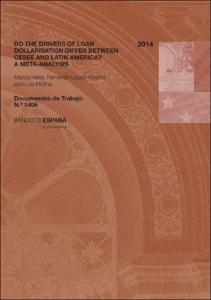Do the drivers of loan dollarisation differ between CESEE and Latin America? : a meta-analysis
Authors
Issue Date
2-Apr-2014
Physical description
34 p. : gráf., tab.
Abstract
In this paper we compare the determinants of loan dollarisation in two emerging market regions, namely Central, Eastern and Southeastern Europe (CESEE) and Latin America, by means of a meta-analysis of 32 studies that provide around 1,200 estimated coefficients for six drivers of foreign currency lending. One common pattern we identify is that macroeconomic instability (as expressed by inflation volatility) and banks’ funding in foreign currency play a significant role in explaining loan dollarisation in both regions. By contrast, the interest rate differential appears to be a key determinant only in Latin America, while the positive impact of exchange rate volatility on dollarisation implies a more prominent role for supply factors in the CESEE region. While the robustness of the results has been verified, our meta-analysis shows that estimates reported in the literature tend to be influenced by study characteristics such as the methodology applied and the data used
En el presente artículo se comparan los determinantes de la dolarización de los préstamos bancarios en dos regiones, América Latina y Europa Central y Oriental, con una metodología de metaanálisis a partir de 32 estudios previos sobre el tema, que proporcionan unos 1.200 coeficientes estimados para las 6 principales variables macroeconómicas que influyen sobre la aparición de préstamos en moneda extranjera en las economías. Ambas regiones presentan patrones comunes (la estabilidad macroeconómica y la financiación de los bancos en moneda extranjera juegan un papel relevante a la hora de explicar la dolarización de los préstamos), pero también claras diferencias, como el hecho de que el diferencial de tipos de interés sea una variable determinante tan solo en América Latina, mientras que en Europa Central y Oriental tenga mayor influencia la volatilidad del tipo de cambio. Estas diferencias apuntarían a una mayor prominencia de los factores de demanda en el caso de América Latina, y de oferta en Europa del Este, a la hora de determinar la concesión de un préstamo en moneda extranjera
En el presente artículo se comparan los determinantes de la dolarización de los préstamos bancarios en dos regiones, América Latina y Europa Central y Oriental, con una metodología de metaanálisis a partir de 32 estudios previos sobre el tema, que proporcionan unos 1.200 coeficientes estimados para las 6 principales variables macroeconómicas que influyen sobre la aparición de préstamos en moneda extranjera en las economías. Ambas regiones presentan patrones comunes (la estabilidad macroeconómica y la financiación de los bancos en moneda extranjera juegan un papel relevante a la hora de explicar la dolarización de los préstamos), pero también claras diferencias, como el hecho de que el diferencial de tipos de interés sea una variable determinante tan solo en América Latina, mientras que en Europa Central y Oriental tenga mayor influencia la volatilidad del tipo de cambio. Estas diferencias apuntarían a una mayor prominencia de los factores de demanda en el caso de América Latina, y de oferta en Europa del Este, a la hora de determinar la concesión de un préstamo en moneda extranjera
Publish on
Documentos de Trabajo / Banco de España, 1406
Subjects
Foreign currency loans; CESEE; Latin America; Meta-regression; Random effects maximum like lihood; Préstamos en moneda extranjera; América Latina; Europa del Este; Metaanálisis; Créditos; Política monetaria; Modelización econométrica; América Latina; Europa Central; Europa Oriental
Appears in Collections:












